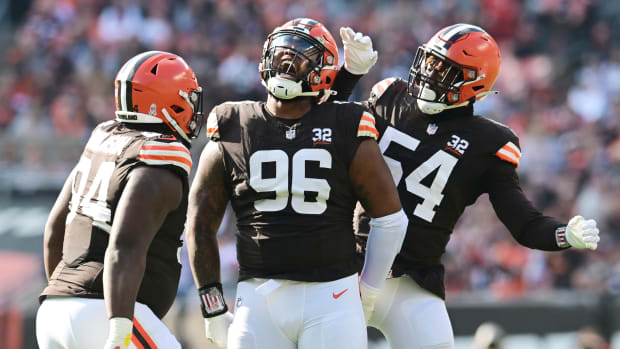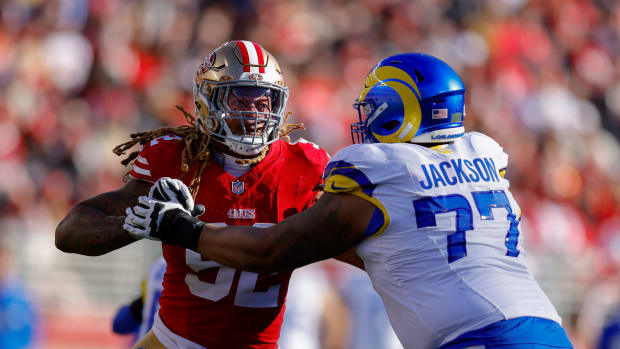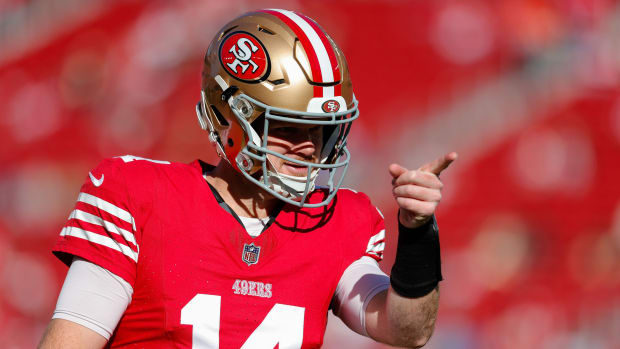Matty Ice Is On Fire
Through the first quarter of the season, the Falcons are an offensive juggernaut. Their 38 points a game are 7.3 more than the league’s No. 2 scoring team (Eagles). Their average 478.8 yards are 83 more than the No. 2 team (Cowboys). Their 354.2 passing yards per game are 50 more than the No. 2 team (Saints). Though it’s still early in the season, these margins are among the best in NFL history.
Not bad for an offensive system that, according to seemingly every preseason prediction, didn’t fit its players—especially the quarterback. So what’s gotten into these birds?
• PETER KING’S MAILBAG: Why Sam Bradford Is MVP
First, understand that offensive coordinator Kyle Shanahan’s system never was a bad fit; the only flaw was outsiders’ analysis. People looked at Matt Ryan’s history as a pocket passer and assumed he couldn’t work in a scheme that frequently moves the quarterback. But Ryan had significantly improved his mobility before Shanahan arrived in Atlanta in 2015 season. The year before, previous offensive coordinator Dirk Koetter had challenged the veteran QB to improve in this department and Ryan took it to heart.
• COLLEGE COLUMN: The Unexpected NFL Pipeline From Eastern Illinois
Ryan’s struggles last year under Shanahan were mostly a result of bizarre mishaps in ball security—an occasional inaccurate pass, dumb decision or careless fumble. Those items have been cleaned up; Ryan has two picks and no fumbles through four games. But here’s the remarkable thing: Ryan’s passing looked great on paper but didn’t become truly sharp until last week against the Panthers. Not sharp by his standards, anyway. Ryan struggled a number of times in Weeks 1, 2 and 3 with ball placement—both with incompletions and several completions that would have yielded more yardage had receivers not been forced to adjust to the ball.
History says Ryan will ultimately be accurate, which makes it plausible that Atlanta’s offense could become even more dangerous. What, exactly, is Shanahan running?
Most notably, it’s zone-action—a zone running game and a passing game that often presents an initial zone-running look. So many of the Falcons’ plays appear the same at the snap.
Take, for example, how often they line up in condensed formations (with the wide receivers aligned tight to the formation, inside the painted field numbers). From those tight splits, receivers can create more favorable angles for perimeter blocks in the outside zone-running game. Those splits are also ideal for setting up faster-hitting play-action, because the receivers are closer to the linebackers whom quick play-action fakes are designed to manipulate. And when it’s not play-action, the condensed formations still give receivers more space to operate, since there’s now more room between them and the sideline. In theory, each receiver gets afforded the “two-way go” that usually only slot receivers and tight ends enjoy.
One of the biggest misconceptions in football is that you must establish the run in order to execute play-action passes. Yes, play-action is helped by a strong ground game. But by no means is it dependent on one. Defenders react to the offense’s movement. For linebackers, their first read is the offensive line. If offensive linemen fire off the ball in a run-blocking look, it’s a defender’s job (and instinct) to react accordingly. Never does a defender see a lineman fire off and think, Hey, this team has only gained 19 yards on seven runs today. I’m not defending this. A defender will always respond, at least initially, to a run look.
• FANTASY 40: Who to Freak Out About, Who to Not Freak Out About and a Carson Palmer Theory
This is especially true against outside zone play-action schemes such as Atlanta’s. Outside zone blocks involve all five offensive linemen moving in unison. Naturally, they’re slower to unfold. And so a defender can’t afford the gamble of thinking the run action he’s seeing won’t actually become a running play. If he’s wrong, there’s either an easy outside edge or a backside running lane for the ballcarrier to burst through.
Shanahan understands all this, and he’s built one of the league’s best misdirection play-action games to exploit it. When opposing linebackers react correctly to Atlanta’s zone looks, there’s a high likelihood the Falcons will have a receiver crossing back the other way—or a tight end or back releasing into the opposite flat. Overall, the Falcons are averaging a staggering 12.55 yards per attempt on play-action and, in just four games, have generated 10 plays of 20 yards or more in this department.
It helps that when the Falcons have run the ball, they’ve been proficient. Their 124.5 rushing yards a game rank sixth in the league. Their top back, Devonta Freeman, with his understanding of how to set up angles and his explosive second gear, is the sport’s best pure outside zone runner. His partner, Tevin Coleman, is bigger and, while not as electrifying, still quicker than most backs. As zone running goes, Coleman isn’t far behind Freeman. It’s easily the best one-two running back tandem in football. The fact that both are also effective in the passing game—Coleman has really improved here, and Atlanta leads the league in running back receiving yardage—makes the Falcons that much more dangerous. Shanahan has even made use of Freeman and Coleman on the field together, which almost always ensures that one gets to run routes against an overmatched linebacker.
We might not see Coleman this week in Denver. He suffers from sickle cell trait and so playing at altitude presents safety concerns. But two others we will see who also define Atlanta’s zone game are center Alex Mack and fullback Patrick DiMarco. No outside zone run can succeed without a center crossing the face of a nose tackle and sealing him to the inside of the flow. Mack continues to be one of the very best at this. DiMarco is unique because he presents a lead-blocking element. Lead blockers essentially create two gaps after the snap. The runner follows the lead-blocker and can cut behind to the left (Gap 1) or to the right (Gap 2). And so we’re talking about a proficient zone ground game that can also create gaps on the fly. That presents a lot of complications for linebackers and safeties. (And this is to say nothing or DiMarco’s sheer ability to physically displace the first defender who shows in his running back’s path.)
We have a smart veteran QB who’s improved in key areas; smart play designs built largely on deception; talented runners and the right kind of blockers for them. And, of course, a wide receiver who just went for 300 yards against one of the most accomplished defenses of this era.
Julio Jones is great at everything, but the area he’s strongest in just happens to match up perfectly with Shanahan’s scheme. That’d be running in-breaking routes such as posts, slants and digs. Jones, with his combination of size/strength and efficient change-of-direction, sets the bar here. Those in-breakers are key for play-action, where receivers’ patterns go behind linebackers who have just bit on a fake. Jones is potent not just out of Atlanta’s staple condensed formations, but also in situations where the receivers have to split out wide—something the Falcons did with regularity last week in order to offset Carolina's speed and athleticism at linebacker and along the defensive line. And on slower developing play-action, which is designed to manipulate safeties instead of linebackers, Jones is as lethal as any deep threat in the game.
Last season no receiver saw more dedicated double-teams than Jones. That’s mostly continued this season despite new No. 2 receiver Mohamed Sanu being an upgrade over a declining Roddy White. This is where Ryan’s comfort in Shanahan’s system has noticeably elevated the most. Ryan has consistently made defenses pay for doubling his No. 1 receiver. In the Week 3 Monday night game at New Orleans, for instance, Jones had just one catch, but Ryan amassed 224 yards and a passer rating of 136.2 throwing to everyone else. The previous week, Ryan had made the Raiders pay for regularly cheating a safety to Jones on the weak side.
Of course, the Saints and Raiders aren’t premiere defenses. The Panthers are, which is why the football world was abuzz about Ryan’s 503-yard performance. But without question, the Broncos this Sunday will be the best defense the Falcons have faced, and probably will face, under Shanahan. We’ll know a lot more about this offensive juggernaut come Monday morning.
• Question? Comment? Story idea? Let us know at talkback@themmqb.com





































